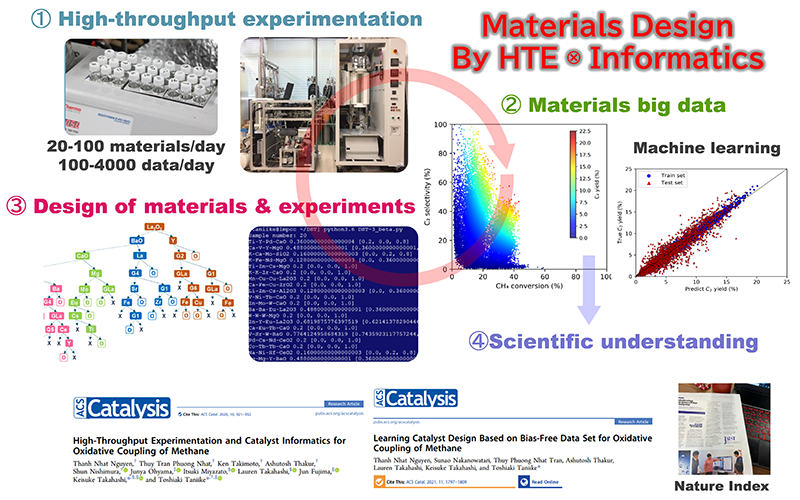
Advanced Material Design based on Exploration, Learning, and Prediction
Laboratory on Materials Informatics
Professor:TANIIKE Toshiaki
E-mail:
[Research areas]
High-throughput experimentation, materials informatics, computational chemistry
[Keywords]
Heterogeneous catalysis, polymerization, nanocomposites, membranes, graphene, data science
Skills and background we are looking for in prospective students
Our research areas are highly multidisciplinary, where students from various backgrounds, not only chemistry (catalysis, polymer, nanomaterials, etc.) but also engineering, data science, computation, and so on, are welcome.
What you can expect to learn in this laboratory
Students will acquire 1) advanced research methodologies based on high-throughput experiments, data science, and computational chemistry; 2) a method of strategic planning for maximizing research outcome with given resources; 3) skills to work in an interdisciplinary and international environment.
【Job category of graduates】 R&D for materials science, chemistry, chemical engineering
Research outline
Facing rapid acceleration in science and technology, Taniike laboratory aims to develop and implement innovation-oriented materials science based on high-throughput experimentation (HTE), data science (materials informatics), and simulation. We explore a wide range of materials and provide solutions to the challenges of our society with unprecedented efficiency.
1. High-throughput experimentation
Combination of different elements and materials can bear an astronomical number of possibilities. One of the purposes in materials science is to discover good combinations and a novel way (process) to produce the combinations. We perform HTE using highly automated and/or parallelized instruments. We maximize the throughput of the experiments and change the research style from labor-intensive to brain-intensive works.
2. Data science
HTE generates materials big data which include synthetic conditions, structural characteristics, and performances of the materials. In order to implement efficient exploration of materials, it is not enough only to pick up good ones: It is necessary to clarify a structure-property relationship. Based on approaches of data science and materials informatics, we extract knowledge from the data and further accelerate materials discoveries.
3. Simulation
Developments of computers and computational chemistry have enabled realistic simulation of complicated materials. Nonetheless, virtual materials design in computers (i.e. in-silico design) is still far to be practical. The most difficult task is how to obtain a molecular model which represents a material. We use experiments and simulations in a comprehensive fashion for establishing a high-precision molecular model towards in-silico materials design. Computational chemistry based on deep understanding of experimental materials science is aimed.
Together with HTE instrumental development and data science programming, we focus on five subjects: Catalyst & polymer informatics; structure-performance relationship; nanomaterials like MOF, graphene; polymer nanocomposites.

Materials research and development based on
high-throughput experimentation and materials informatics
Key publications
- L. Takahashi, T. Taniike, K. Takahashi et al., Constructing Catalyst Knowledge Networks from Catalysts Big Data in Oxidative Coupling for Methane for Designing Catalysts, Chemical Science 2021, 12, 12546-12555 (press released, selected as Front Cover).
- T.N. Nguyen, K. Takahashi, T. Taniike et al., High-Throughput Experimentation and Catalyst Informatics for Oxidative Coupling of Methane, ACS Catalysis, 2020, 10, 921-932 (press released).
- G. Takasao, Toru Wada, T. Taniike et al., Machine Learning-Aided Structure Determination for TiCl4-Capped MgCl2 Nanoplate of Heterogeneous Ziegler-Natta Catalyst, ACS Catalysis, 2019, 9, 2599-2609.
Equipment
Andrew+ Pipetting robot
Multipurpose parallel reactor (developed in-house)
Microwave synthesizer with a robotic arm
Catalyst screening instruments (developed in-house)
Photocatalyst screening instrument (developed in-house)
Operando chemiluminescence analyzer (developed in-house)
Chemiluminescence imaging instruments (developed in-house)
In-situ mid/far-IR spectrometer
Laser Raman spectrometer
Microplate reader
X-ray diffractometer with an autosampler
X-Ray fluorescence spectrometer with an autosampler etc.
Teaching policy
There is no core time in our laboratory: The throughput of experiments and the research itself is maximized in order to assure the work-life balance. On the other hand, extensive discussion is regularly made based on experimental group meeting (once a few weeks) and colloquium (once a month). The attendance of domestic and international conferences is fully supported.
[Website] URL:https://www.jaist.ac.jp/ms/labs/taniike/en/